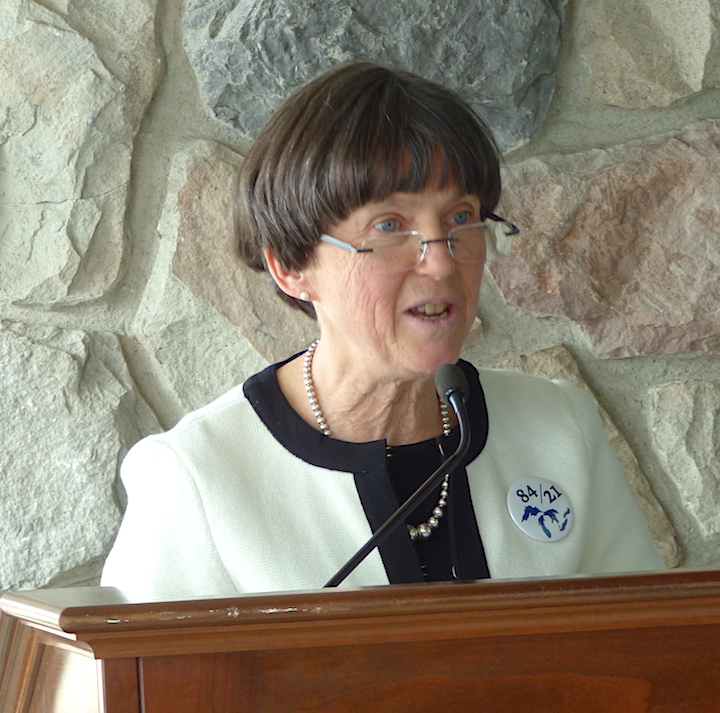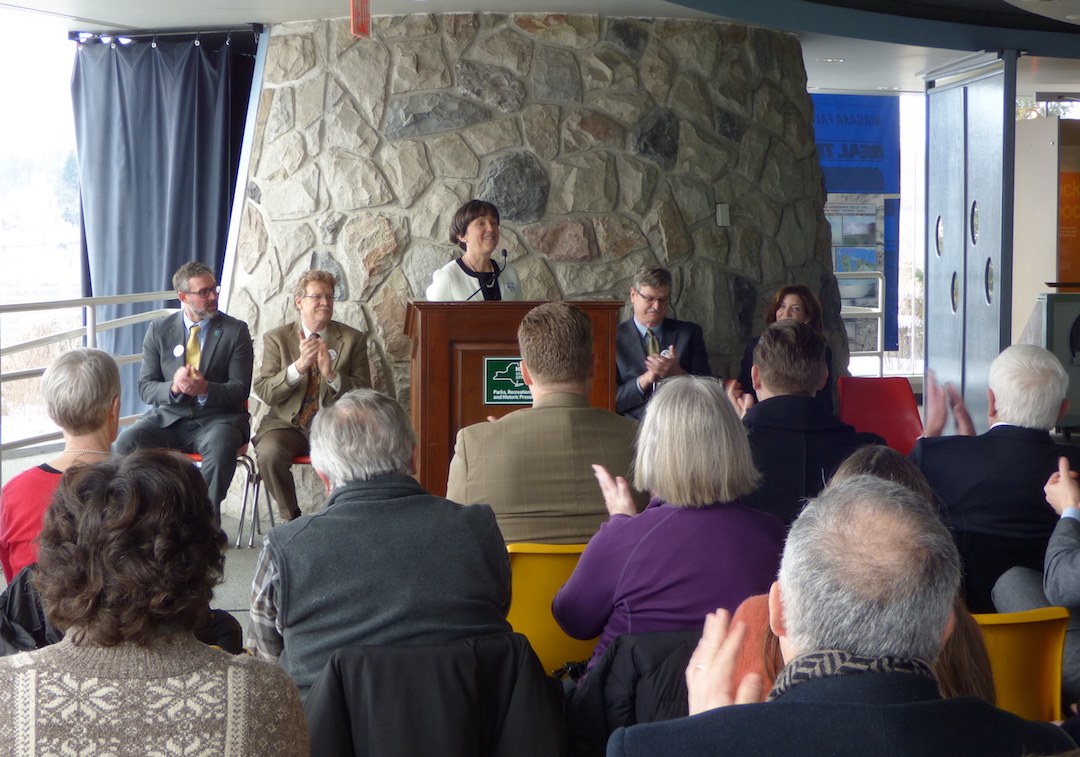Work will control invasive species in Niagara Gorge; project complements other state investments in Niagara Falls State Park, Niagara Falls' downtown district
Pictures & maps of gorge can be downloaded HERE
Watch video highlights below
Gov. Andrew M. Cuomo on Monday announced work will begin for on-the-ground ecological restoration work to "Restore the Gorge" in Niagara Falls.
Beginning in February, the Western New York Land Conservancy will begin the two-year mission to control invasive species and plant native trees, shrubs, grasses and flowers in the Niagara Gorge from the Niagara Gorge Discovery Center to Devil's Hole State Park. The $2.1-million project is supported by a variety of state funds, including Buffalo Billion Phase II. It complements Cuomo's $70 million revitalization of Niagara Falls State Park and other strategic state investments to strengthen the tourism industry in downtown Niagara Falls.
"The Niagara Gorge is central to the natural beauty of the world-class attraction Niagara Falls," Cuomo said. "The ecological restoration of this biologically diverse habitat goes hand in hand with our strategic investments that are reinvigorating tourism in Niagara Falls and our dedication to revitalizing the region."
The Western New York Land Conservancy has been leading efforts to restore and enhance the natural habitat on 33 acres of land along the gorge with funding from the New York Power Authority via the Niagara Greenway Commission Ecological Standing Committee. With the addition of Buffalo Billion Phase II funding, the Land Conservancy will be able to remove invasive species and restore an additional 125 acres within the gorge and along the rim from Whirlpool State Park to Devil's Hole State Park. This project will transform the ecological health of the Niagara River Gorge and rim and enhance the visitors' experience at Niagara Falls.
As one of the most biologically diverse places on the Great Lakes, the Niagara Gorge is home to unique ecological communities, including many rare plants, and is also part of a globally significant Important Bird Area. The lower Niagara River rapids are important spawning grounds for freshwater fish, including threatened lake sturgeon.
Unfortunately, the health of this sensitive environment has been harmed by many factors, especially non-native invasive plants. The Land Conservancy has hired Applied Ecological Services to remove harmful invasive plants such as common buckthorn, tree-of-Heaven and phragmites for the first phase of the project. These invasive species will be replaced with beneficial natives such as oak trees, ninebark shrubs and Canada anemone.
Hochul at the podium
"The state's investment through the Buffalo Billion to control invasive species and plant native trees, shrubbery, grass and flowers in the Niagara River Gorge will enhance and restore one of the most majestic natural wonders of the world," said Lt. Gov. Kathy Hochul, who spoke at the announcement. "The governor's unprecedented commitment to this project builds on the state's multimillion-dollar investments to promote Niagara Falls as a world-class tourist destination."
Land Conservancy Executive Director Nancy Smith said, "Today we celebrate an opportunity for the world to rediscover the magic of the Niagara Gorge as a vital and magnificent window on Niagara Falls. The Land Conservancy's work will reweave the diverse and complex fabric of life that blankets the gorge. This tapestry of cedars and ferns, asters and little blue stem grasses are the native plants that feed the wildlife we love, clean our fresh water and support the pollinators that put food on our table. They are the foundation for our mysterious web of life. This is the story we can share with everyone who visits the gorge."
Land Conservancy Executive Director Nancy Smith addresses local leaders and media members. (Photos by Joshua Maloni)
This is just one of the projects New York state has committed to as it works to encourage the City of Niagara Falls' true potential as a world-class tourist destination. Other projects undertaken by the state include $70 million in recent renovations to Niagara Falls State Park; $62 million dedicated to the removal of underused expressway segments; multiple completed, in progress and planned hotel projects; Niagara Falls Redevelopment, which involves the acquisition of a number of key underutilized properties within a city block of Niagara Falls State Park for mixed-use development; and $240 million in public and private development in downtown Niagara Falls.
This project is supported by $1 million from Buffalo Billion Phase II, nearly $1 million from Niagara River Greenway Commission's Greenway Ecological Standing Committee and a $100,000 grant from Oath Community Benefit Fund for Niagara County by the Empire State Development. Land in the project area is owned by the New York Power Authority and by the New York State Office of Parks, Recreation, and Historic Preservation.
City of Niagara Falls Mayor Paul Dyster said, "Today marks the first day in a significant process to protect and restore one of our region's most valuable assets. With $1 million in Buffalo Billion Phase II funding dedicated to enhancing our ecosystem for wildlife and visitors alike, Gov. Cuomo's latest investment into the City of Niagara Falls will have a transformative impact for years to come."
Empire State Development President, CEO and Commissioner Howard Zemsky said, "Gov. Cuomo, through the Buffalo Billion and many other state investments, has made the City of Niagara Falls one of his signature priorities. The work being done in the Niagara Gorge will expand improvements to the state parks and surrounding area and further establish Niagara Falls as a world-class tourism destination."
State Parks Commissioner Rose Harvey said, "We are grateful to Gov. Cuomo and the Land Conservancy for their commitment to the Niagara Gorge. It is a very special place that requires careful stewardship. A revitalized Niagara Gorge will certainly complement our investments in nearby state parks that will further deepen the visitor experience."
NYPA Chairman John Koelmel said, "NYPA is committed to generating clean, renewable energy while preserving natural resources and supporting the expansion of space for outdoor recreation. The restoration of the habitat in the Niagara Gorge is a smart investment that will continue to bolster the transformation of the Niagara Falls area into an even more valued ecological asset, and further boost the tourism potential of the entire region. The project is an excellent use of land owned by NYPA coupled with funding committed through the Niagara River Greenway Fund Ecological Standing Committee."
Niagara River Greenway Ecological Standing Committee Co-Chair Tim DePriest said, "The restoration of the Niagara Gorge is a great step forward in the conservation of one of New York state's ecological treasures and advances the fundamental goals of the Niagara River Greenway Plan. The Greenway Ecological Standing Committee is proud to support this effort and is confident in the abilities of the Western New York Land Conservancy to bring success to this ambitious project, just as they have demonstrated with their other Greenway projects."
Congressman Brian Higgins said, "The Niagara Gorge is a majestic natural destination, which provides an experience and vistas like none other. Effort led by Western New York Land Conservancy to restore the gorge will provide lasting ecological and economical returns for years to come."
New York State Sen. Rob Ortt said, "Ensuring we do everything possible to preserve the incredible ecosystem surrounding the Niagara Gorge is vitally important for conservation and economic vitality. The invasive species present in the gorge threatens the natural beauty as well as the lifespan of plant and animal species native to our area. This conservation effort is a necessary project to safeguard our natural wonder, and I am happy to see a joint effort put forth by state agencies to combat this issue."
Assemblyman Angelo Morinello said, "I applaud the governor and the Western New York Land Conservancy on their land preservation work through the 'Restore the Gorge' project. The Niagara Gorge is an ecological treasure in Western New York's backyard, and I'm encouraged by the effort to restore this natural beauty. With continued efforts to preserve state land, we can incentivize increased tourism and conserve New York's natural wonders for all to see and enjoy."
During the two-year project, there will be trail closures for the safety of visitors to this area in the Niagara Gorge. Trail closures will be temporary and intermittent while crews are working in areas that may cause rocks or debris to fall. These closures will only occur during daytime hours on weekdays, and trails will not be closed on evenings or weekends. A list of closed trails can be found
HERE.To learn more about this project and what individuals can do like planting native plants on their own property, the Land Conservancy will host a talk by nationally renowned, native plant expert Doug Tallamy at the New York Power Vista on Friday, March 16. Details on this talk can be found at
wnylc.org.
The Western New York Land Conservancy is a regional, not-for-profit land trust that permanently protects land with significant conservation value in Western New York for future generations. The Land Conservancy envisions a future in which open spaces, working lands, wildlife habitat and scenic beauty are cherished and protected as part of the landscape and character of Western New York. The Land Conservancy is accredited by the Land Trust Accreditation Commission and is one of 1,700 land trusts nationwide, including 90 in New York.
Land trusts have protected 40 million acres over the past 20 years. For more information on upcoming events, volunteer opportunities, or the mission of the Western New York Land Conservancy, call 716-687-1225 or visit
www.wnylc.org.
WATCH:
































